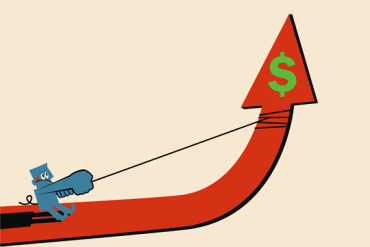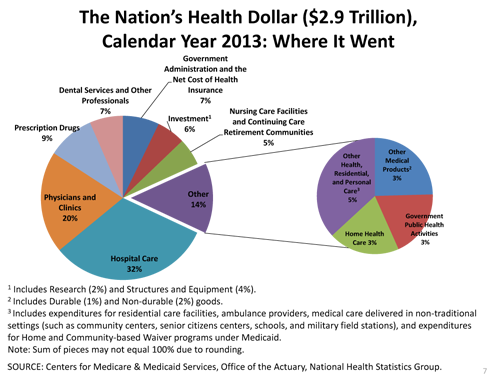National health spending grew 3.6 percent in 2013, the lowest annual increase since the Centers for Medicare and Medicaid Services (CMS) began tracking the statistic in 1960, officials said Wednesday.
Spending slowed for private health insurance, Medicare, hospitals, physicians and clinical services and out-of-pocket spending by consumers. However, it accelerated for Medicaid and for prescription drugs, according to the report, published online by the journal Health Affairs.
Health care spending has grown at historically low rates for the past five years, which is consistent with declines generally seen during economic downturns, such as the Great Recession that crippled the U.S. economy at the end of 2007. Looking ahead, “the key question is whether health spending growth will accelerate once economic conditions improve significantly; historical evidence suggest that it will,” noted the authors, who are from the CMS Office of the Actuary.

They also pointed out, however, that in the near term, the health sector will “undergo major changes that will have a substantial impact” on consumers, providers, insurers and sponsors of health care. These are the result of the health law’s creation of online marketplaces, its expansion of Medicaid, a shared federal-state health care program for the poor and disabled, and restraints the law made to the Medicare program, the analysts found.
“The balance of these and many other factors over the next few years will determine how the historically low health spending growth from 2009 to 2013 is viewed: as the temporary aftermath of the great recession or the beginning of a new era,” the authors wrote.
The study found that health care spending rose to $2.9 trillion, or $9,255 per person, in 2013. As a share of gross domestic product, health care remained at 17.4 percent, the same share since 2009, the CMS researchers found.
The 3.6 percent spending growth for 2013 tracks a CMS estimate from September and is 0.5 percentage point lower than 2012.
Spending on Medicare grew 3.4 percent in 2013, down from the 4 percent growth in 2012. The difference was due mostly to slower growth in enrollment and spending changes included in the health care law, including reductions in federal payments to the private Medicare Advantage plans that offer an alternative to traditional Medicare. The automatic 2 percent federal budget payment cuts, known as sequestration, also played a role in reducing Medicare spending, which was nearly $586 billion in 2013. The program accounted for 20 percent of national health spending, according to the report. Fee-for-service expenditures, which account for 72 percent of total Medicare spending, were up 1.7 percent in 2013. Medicare Advantage spending increased 7.8 percent in 2013, a slower growth rate that the 10.6 percent increase in 2012.
The growth in Medicare per-enrollee spending was relatively flat, increasing 0.2 percent after a growth rate of less than 0.1 percent in 2012. The authors credited younger and healthier baby boomers entering the program.
Medicaid spending increased 6.1 percent in 2013, following growth rates of 2.5 and 4 percent, respectively, in 2011 and 2012. A variety of factors, including increases in hospital care – which accounts for 36 percent of Medicaid spending — contributed to the cost increase. The federal government and state and local governments spent $449.4 billion in 2013 on Medicaid, accounting for 15 percent of total national health expenditures.
Medicaid enrollment grew 2.7 percent during that time frame, the first acceleration since 2009. Some of the 2013 increase was due to new beneficiaries who enrolled as part of the health law’s provision that allowed states to expand their Medicaid programs ahead of the 2014 expansion.
Other key takeaways from the report include:
— Nearly 190 million people – or 60 percent of the population – were covered by private health insurance in 2013. Premiums grew 2.8 percent, compared to an increase of 4 percent in 2012. Low overall enrollment growth, greater usage of high deductible plans and other benefit design changes and the health law’s medical loss ratio and rate review provisions contributed to the decline, CMS found. Private health insurance enrollment increased 0.7 percent last year, the third straight year of growth.
— Consumer out-of-pocket spending, including co-payments and deductibles or payments for services not covered by a consumer’s health insurance, was $339.4 billion in 2013, or 12 percent of national health expenditures. The 2013 growth was down from the 3.6 percent growth in both 2011 and 2012.
— Spending for physician and clinical services grew 3.8 percent in 2013 to $586.7 billion, a slowdown from 2012 when spending grew 4.5 percent. Expenditures for hospital care increased 4.3 percent in 2013, slower than the 5.7 percent rate of growth in 2012. Total spending growth for retail prescription drugs rose 2.5 percent last year, compared to 0.5 percent in 2012. Drug spending growth increased in 2013 for several reasons, among them higher prices for brand-name and specialty drugs.

Source: CMS






